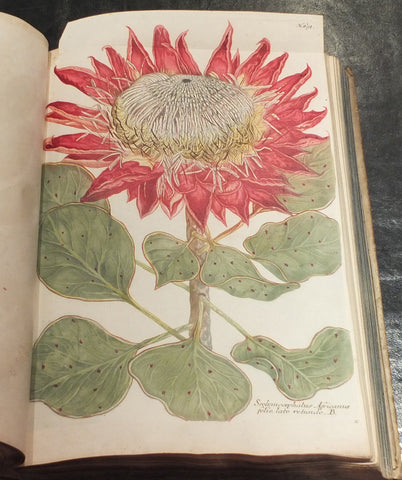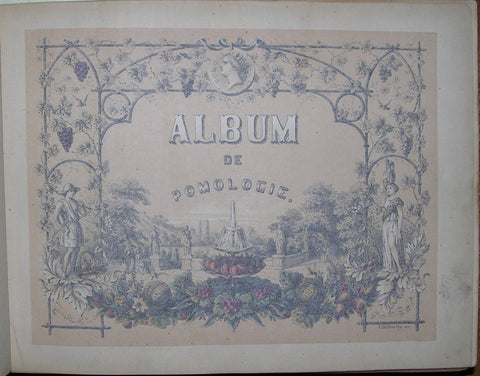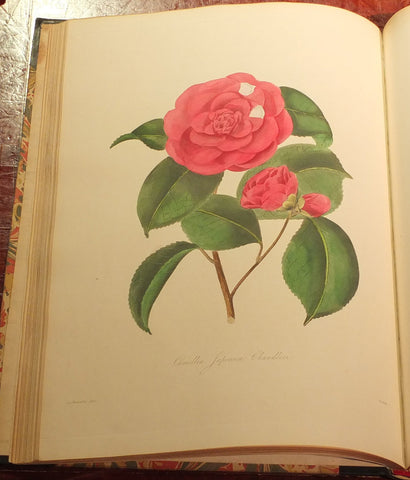Johann Wilhelm Weinmann (died 1741) - Georg Dionysius Ehret (1708-1770) - DIETRICHS, J.G.N. - DIETRICHS L.M. - BIELER, A.K. Phytanthoza iconographia; sive Conspectus aliquot millium...
Johann Wilhelm Weinmann (died 1741) - Georg Dionysius Ehret (1708-1770) - DIETRICHS, J.G.N. - DIETRICHS L.M. - BIELER, A.K.
Phytanthoza iconographia; sive Conspectus aliquot millium...
WEINMANN, Johann Wilhelm (died1741) - EHRET, Georg Dionysius (1708-1770) - DIETRICHS, J.G.N. - DIETRICHS L.M. - BIELER, A.K. Phytanthoza iconographia; sive Conspectus aliquot millium, tam indigenarum quam exoticarum, ex quatuor mundi partibus, longa annorum serie indefessoque studio ... collectarum plantarum, arborum, fruticum, florum fructuum, fungorum. Text by J.G.N. Dietrichs, L.M. Dietrichs, and A.K. Bieler. Regensburg: Hieronymus Lentzen [volume IV: Heinrich Georg Neubauer], 1735-1737-1745.
Together 8 volumes. Folio (15 x 9 6/8 inches). 4 text volumes: 2 frontispiece mezzotint portraits printed in blue by Haid after Hirschmann of Weinmann and Bieler, frontispiece mezzotint in blue of Allegorical Flora by Haid after Baumgartner. Latin, French and German title-pages to index printed in red and black and bound at beginning of the first text-volume along with a foreword by Albrecht Haller in German, the German and Latin index itself bound in at the end of the last text volume, Latin and German title-pages in other volumes, all printed in red and black, letterpress interleaved with blank leaves, parallel text in double columns and indices in both languages.
4 plate volumes: Exceptionally fine folding engraved and mezzotint plate of Aloe Americana folio Mucronato printed in colours and finished by hand on two joined sheets, signed in ink manuscript by J. Haid and bound in between plates 62 and 63 in volume one, 1024 (of 1025) numbered engraved and mezzotint botanical plates by B. Seuter, J.E. Ridinger and Haid after G.D. Ehret, N. Asamin and others, all printed in colour and finished by hand, 15 of which double-page and folding, plate 982 with folding wing, additional plate from another work tipped in before plate 276 in volume II (without plate 525, pale marginal waterstaining to plates 1-26 and 480-498, waterstaining entering into plate images of 506-524, tiny repairs to versos of plates 90 and 443, plate 702 with tiny area of abrasion affecting the colour, preliminaries to second plate volume repaired along the top margin). Contemporary vellum over paste-board, blue edges, spines lettered in both contemporary and 20th-century manuscript (lightly soiled, extremities a little scuffed).
Provenance: with the 19th-century lithographed library label of Friedrich Knapp with inventory number 1115 in manuscript, on the front paste-down of the first text volume, and removed from some others; with the engraved bookplates of Freiherr Ernst von Grunelius, Freifrau Anna von Grunelius née Gräfin von Bernstorff dated 1928, on the front paste-down of each volume; with the small ink library stamp of Dresden Central Art Library on the verso of each plate
WITH THE VERY RARE LARGE FOLDING PLATE OF THE 'CENTURY PLANT', Aloe Americana folio Mucronato, so called because of the time it takes to flower (actually between 10 and 60 years, depending on the warmth of its growing location). There are two states of this plate: one is signed 'J.J. Haid f. excud' and appears to be a separately published plate; the other is unsigned, as is this example, but is HERE SIGNED IN MANUSCRIPT BY THE ARTIST. Only one copy of the separate plate and four copies (one incomplete) of Phytanthoza with this extra plate can be traced as selling at auction in the past 35 years. The copies at Royal Botanic Gardens Kew, NHM, BL, Cambridge, Oxford and Wellcome are all without this plate.
THE FIRST EDITION OF ONE OF THE EARLIEST WORKS TO USE COLOUR-PRINTING FROM A SINGLE PLATE. The work was issued in parts, and in more than one issue, and the make-up of the preliminary leaves and indices is known to vary between copies.
A comprehensive and beautiful record of known 18th-century flowers, fruits, and vegetables. Financed by Weimann, director of the oldest pharmacy in Regensburg, who commissioned amongst other artists the now celebrated Georg Ehret. It was his first major commission, but he was not credited, and only received half of his promised wages, on the grounds that he had only supplied about half of the 1,000 that Weinman was expecting of him. However, even at this early stage in his career, Ehret's style is easily identified, particularly in various aloes and cacti growing in distinctive pots and urns that is a feature of Ehret's work for his own "Plantae et papiliones rariores" (1748-1759).
The "Phytanthoza ..." was a very important influential book. Filippo Arena borrowed heavily from it for his "La Natura, e coltura de' fiori" (1767-1768), and the dutch edition was imported to Japan where it "gave rise to a major change in illustrated botanical literature... and led to the productions from 1830 onwards of the illustrated herbal "Honzo Zufu..." by Iwasaki Kanen in ninety-six volumes" (Blunt pages 155-156).
Like his father before him Ehret trained as a gardener, initially working on estates of German nobility, and painting flowers only occasionally, another skill taught him by his father, who was a good draughtsman. Ehret's "first major sale of flower paintings came through Dr Christoph Joseph Trew, eminent physician and botanist of Nuremberg, who recognized his exceptional talent and became both patron and lifelong friend. Ehret sent him large batches of watercolours on the fine-quality paper Trew provided. In 1733 Trew taught Ehret the botanical importance of floral sexual organs and advised that he should show them in detail in his paintings. Many Ehret watercolours were engraved in Trew's works, such as 'Hortus Nitidissimus' (1750-86) and 'Plantae selectae' (1750-73), in part two of which (1751) Trew named the genus Ehretia after him.
"During 1734 Ehret travelled in Switzerland and France, working as a gardener and selling his paintings. While at the Jardin des Plantes, Paris, he learned to use body-colour on vellum, thereafter his preferred medium. In 1735 he travelled to England with letters of introduction to patrons including Sir Hans Sloane and Philip Miller, curator of the Chelsea Physic Garden. In the spring of 1736 Ehret spent three months in the Netherlands. At the garden of rare plants of George Clifford, banker and director of the Dutch East India Company, he met the great Swedish naturalist, Carl Linnaeus, who was then formulating his new classification based on plant sexual organs. Ehret painted a Tabella (1736), illustrating the system, and sold engravings of it to botanists in Holland. Some of his paintings of the exotics were engraved in Linnaeus's "Hortus Cliffortianus" (1737).
"[Ehret] signed and dated his work, naming the subject in pre-Linnaean terms. He published a florilegium, "Plantae et papiliones rariores" (1748-62), with eighteen hand-coloured plates, drawn and engraved by himself... Ehret also provided plant illustrations for several travel books. His distinctive style greatly influenced his successors" (Enid Slatter for DNB). Arnold Arboretum p. 738 (with an additional French title-page in vol. I); BM(NH) V, 2285; Brunet II, 704 (under Dietrichs); Dunthorne 327; Great Flower Books (1990) p.151; Cleveland Collections 388; Nissen BBI 2126; Pritzel 10140; Stafleu-Cowan TL2 17050.
We Also Recommend





















